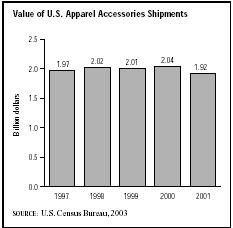SIC 2389
APPAREL AND ACCESSORIES, NOT ELSEWHERE CLASSIFIED
This industry consists of establishments primarily engaged in manufacturing suspenders, gaffers, handkerchiefs, and other apparel not elsewhere classified, such as academic caps and gowns, vestments, and theatrical costumes. Also included are establishments primarily engaged in manufacturing clothing by cutting and joining (for example by adhesives) materials such as paper and nonwoven textiles.
NAICS Code(s)
315999 (Other Apparel Accessories and Other Apparel Manufacturing)
315299 (All Other Cut and Sew Apparel Manufacturing)
315231 (Women's and Girls' Cut and Sew Lingerie, Loungewear, and Nightwear Manufacturing)

315212 (Women's and Girls' Cut and Sew Apparel Contractors)
315211 (Men's and Boys' Cut and Sew Apparel Contractors)
The number of establishments in this industry, according to the U.S. Census Bureau, exceeded 400 in the early 2000s. The total value of shipments in 2001 was $1.92 billion, down from $2.02 billion in 1998. Like most other segments of the apparel industry, the accessories sector struggled with sluggish sales as the U.S. economic slide that took place at the turn of the twenty-first century continued into the early 2000s. Along with a weak economy, U.S. accessories manufacturers also faced a growing onslaught of inexpensive imports, partially the result of China's entrance into the World Trade Organization in December of 2001, as well as the passage of the Uruguay Round agreement, which called for the cessation of textile quotas by 2005.
The apparel and accessories industry comprises a wide variety of products. Ecclesiastical vestments and other clothing makes up a signification portion of sales in this category, as do academic caps and gowns, costumes, and theatrical clothing. Other industry segments include garter belts and garters; hose supporters; arm bands; suspenders; men's, boys', women's, and children's handkerchiefs; and burial garments.
Companies in this industry shipped $1.92 billion worth of goods in 2001. They also spent $1.4 billion on materials, and paid $83 million for payroll expenditures. They employed 28,152 people, including 21,533 production workers who earned an average hourly wage of $11.08. New York had the highest value of product shipments for this industry, followed by South Carolina, California, Florida, and Virginia.
In the early 2000s, less than 10 establishments in the United States manufactured hose supporters, arm bands, suspenders, and handkerchiefs. They shipped $46.7 million worth of goods in 2001. The value of shipments had fluctuated throughout the late 1990s and early 2000s, growing from $53.6 million in 1997 to $55.6 million in 1998, before falling to $51.9 million in 1999, and then rebounding to $53.9 million in 2000.
Labor and occupations are specialized within this category. Historically, more than half of the workers have been sewing machine operators; less than 5 percent have been garment inspectors, testers, and graders; and roughly 3 percent have supervised precision blue-collar workers. Other occupations include pressing machine operators, shipping and receiving clerks, hand packers and packagers, helpers, laborers, and materials movers.
One of the largest firms whose primary business was in this classification was Los Angeles, California-based Simon Worldwide Inc., formerly named Cyrk Inc. However, the firm's position in the early 2000s was questionable as it had lost several key clients in the wake of a marketing scandal. While the firm employed 1,300 workers and posted sales of $757 million in 1998, by 2003 its employee count was down to seven, and losses totaled $8.9 million. Simon's main focus was promotional screen and fabric screen printing. Memphis, Tennessee-based Varsity Brands, Inc., formerly known as Riddell Sports Inc., had 2003 sales of $156.4 million, mainly from manufacturing uniforms for cheerleaders, dance teams, and booster clubs. Paris Accessories Inc. (New York, New York) had sales of roughly $50 million, mainly from manufacturing women's belts and accessories. E.R. Moore Co. (Chicago, Illinois) had estimated sales of $39 million, mainly from manufacturing choir robes, caps, gowns, and accessories.
Historically, about 80 percent of goods manufactured within this industry have been made for personal consumption, 12 percent have been used in apparel made from purchased materials, and 1.5 percent have been exported. The United States usually imports nearly twice as many products in this category as it exports, and the percentage of imports has been growing. Others buying fractional amounts of the output of this industry include, in descending order, the federal government; pleating and stitching operations; knit outerwear mills; hospitals; laundry, dry cleaning, and shoe repair operations; government agencies that buy items for hospitals and health organizations; portrait and photographic studios; and government agencies that buy items for public assistance and relief.
Further Reading
U.S. Census Bureau. "Statistics for Industry Groups and Industries: 2000." February 2002. Available from http://www.census.gov/prod/2002pubs/m00as-1.pdf .
——. "Value of Shipment for Product Classes: 2001 and Earlier Years." December 2002. Available from http://www.census.gov/prod/2003pubs/m01as-2.pdf .
Comment about this article, ask questions, or add new information about this topic: